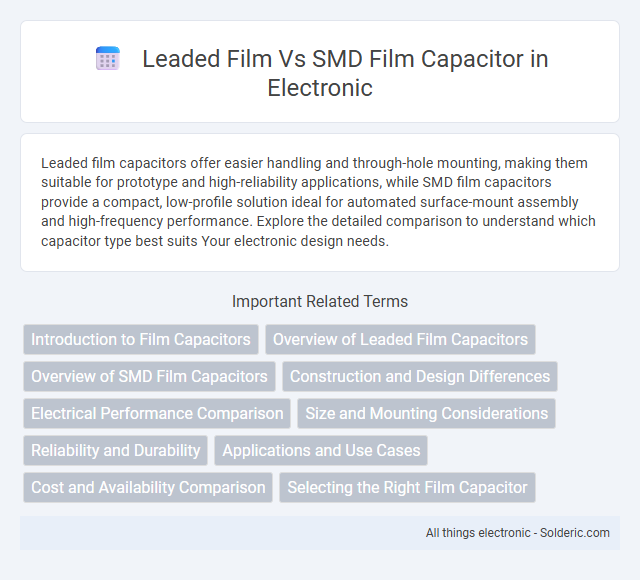Leaded film capacitors offer easier handling and through-hole mounting, making them suitable for prototype and high-reliability applications, while SMD film capacitors provide a compact, low-profile solution ideal for automated surface-mount assembly and high-frequency performance. Explore the detailed comparison to understand which capacitor type best suits Your electronic design needs.
Comparison Table
| Feature | Leaded Film Capacitor | SMD Film Capacitor |
|---|---|---|
| Mounting Type | Through-hole | Surface-mount |
| Size | Larger | Compact, smaller footprint |
| Installation | Manual or wave soldering | Reflow soldering |
| Electrical Performance | High stability, lower ESR | Good performance, slightly higher ESR |
| Applications | Prototyping, high voltage, power electronics | High-density PCB, portable electronics |
| Mechanical Strength | More robust leads | Less mechanical durability |
| Cost | Typically higher due to manual handling | Lower cost in mass production |
Introduction to Film Capacitors
Film capacitors are essential components in electronic circuits, valued for their stability, low inductance, and high insulation resistance. Leaded film capacitors feature wire leads for through-hole mounting, offering easy replacement and robust mechanical strength, while SMD (Surface-Mount Device) film capacitors are designed for compact, automated assembly on printed circuit boards, enabling higher component density. Your choice between leaded and SMD film capacitors depends on application requirements such as space constraints, assembly methods, and electrical performance.
Overview of Leaded Film Capacitors
Leaded film capacitors feature axial or radial leads that facilitate easy insertion into through-hole circuit boards, offering robust mechanical stability and straightforward soldering. These capacitors are known for their high reliability, low dissipation factor, and stable capacitance over a wide frequency range, making them ideal for power supplies, audio circuits, and signal processing. Your choice of leaded film capacitors ensures durability and excellent performance in applications requiring long-term reliability and precise capacitance values.
Overview of SMD Film Capacitors
SMD film capacitors are compact, surface-mount components widely used in modern electronic circuits for their reliable performance and enhanced frequency response compared to traditional leaded film capacitors. Their construction allows for automated assembly on printed circuit boards (PCBs), improving manufacturing efficiency and reducing parasitic inductance. Common dielectric materials include polyester, polypropylene, and polyphenylene sulfide, enabling high stability, low equivalent series resistance (ESR), and excellent thermal characteristics essential for high-frequency filtering and signal integrity.
Construction and Design Differences
Leaded film capacitors feature wire leads for through-hole mounting, with a dielectric film wound or stacked inside a cylindrical casing, providing robust mechanical stability and easier manual assembly. SMD (Surface-Mount Device) film capacitors use a compact, flat chip design with metallized film layers deposited on ceramic or plastic substrates, optimized for automated PCB assembly and high-density circuit integration. The key construction difference lies in the leaded type's wire leads versus the SMD's terminations, directly impacting board space utilization and mounting techniques.
Electrical Performance Comparison
Leaded film capacitors typically offer higher voltage ratings and superior surge current handling compared to SMD film capacitors, making them ideal for power applications. SMD film capacitors excel in high-frequency performance and lower equivalent series resistance (ESR), enhancing efficiency in compact electronics. Your choice depends on whether robustness or miniaturization is prioritized in the electrical performance.
Size and Mounting Considerations
Leaded film capacitors typically have larger physical sizes due to their wire leads, requiring through-hole mounting on PCBs, which can limit high-density circuit designs. SMD film capacitors offer compact, low-profile packages designed for surface-mount technology, enabling space-saving layouts and automated assembly on modern printed circuit boards. The choice between leaded and SMD films directly impacts board real estate, soldering methods, and suitability for high-frequency applications.
Reliability and Durability
Leaded film capacitors exhibit high reliability due to their robust construction and ability to withstand thermal stress, making them ideal for applications requiring long-term stability and durability. SMD film capacitors offer enhanced durability in compact electronic devices by providing resistance to mechanical vibration and shock, although they may have slightly lower power handling compared to leaded types. Both capacitor types maintain stable capacitance over time, but leaded film capacitors generally excel in high-stress industrial environments, while SMD film capacitors suit miniaturized, high-frequency circuits.
Applications and Use Cases
Leaded film capacitors excel in applications requiring easy through-hole mounting and replacement, commonly found in power supplies, audio equipment, and industrial controls due to their durability and high voltage handling. SMD film capacitors dominate in high-density circuit designs such as smartphones, laptops, and automotive electronics, offering compact size and superior high-frequency performance. Both types are chosen based on assembly method and space constraints, with leaded versions preferred for prototyping and repair, while SMD variants suit mass production and miniaturized devices.
Cost and Availability Comparison
Leaded film capacitors generally cost more due to higher manufacturing complexity and limited production volumes compared to SMD film capacitors, which benefit from widespread automated assembly processes. SMD film capacitors are widely available in various capacitance values and voltage ratings, making them more accessible for mass production and high-volume electronics manufacturing. The cost-effectiveness and easy procurement of SMD film capacitors make them the preferred choice for standard industrial applications, while leaded film capacitors remain niche for specific high-reliability uses.
Selecting the Right Film Capacitor
Selecting the right film capacitor depends on the application's space constraints and electrical requirements, with leaded film capacitors offering easier prototyping and higher voltage ratings, while SMD film capacitors provide compact size and superior high-frequency performance. Leaded film capacitors are preferred for through-hole mounting and can handle higher ripple currents, making them suitable for power electronics and audio circuits. SMD film capacitors, commonly found in consumer electronics and telecommunications equipment, are optimized for automated assembly and exhibit lower equivalent series resistance (ESR) and inductance, enhancing circuit efficiency at high frequencies.
Leaded film vs SMD film capacitor Infographic

 solderic.com
solderic.com